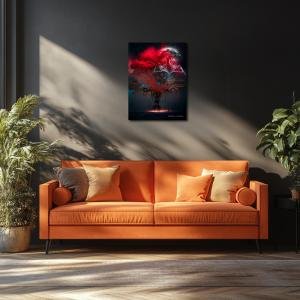Veil of Dawn: Light Coming on the Plains
Veil of Dawn reimagines Georgia O’Keeffe’s Light Coming on the Plains as a celestial awakening, layering her minimalist form within a vast cosmic spectacle. The original soft dome, painted in deep ultramarine and golden ochre, now anchors a surreal sky where planets form, solar winds streak, and galaxies bloom like dawn over the universe. Ethereal hues of silver, lavender, and atmospheric blue merge with rising light, transforming O’Keeffe’s serene morning vision into a meditation on cosmic rebirth and the spiritual weight of new beginnings. Stillness meets infinity, as the plains stretch beyond Earth into the mystery of space.
Please see Below for Details…
Hotline Order:
Mon - Fri: 07AM - 06PM
404-872-4663
Veil of Dawn , a conceptual reimagination of Georgia O’Keeffe’s Light Coming on the Plains , carries the minimalist spirit of her original work into a realm of celestial awakening and cosmic symbolism. The composition retains the essence of O’Keeffe’s vision—a solitary shape, soft and abstracted, against the early light—but expands the metaphor into a meditation on planetary emergence, cosmic rebirth, and the silent power of becoming. Her iconic semi-abstract form, once nestled in the stillness of an American dawn, is now suspended within an unfolding stellar eclipse, casting an otherworldly glow that stretches the meaning of “light” into something mythic.
At the heart of the composition remains O’Keeffe’s original form: a soft, rounded silhouette rising like breath from the horizon. It is painted in a gradient of deep ultramarine and ashen lavender, bleeding upward into ochre and subtle gold, capturing the very moment night loosens its grip and light begins to bloom. This is not light that invades but one that reveals, a presence rather than a force. The form itself holds stillness—curved, grounded, and monolithic like a cairn, a spiritual marker. It remains her ode to the dawn she loved so deeply in the plains of New Mexico, when time seemed to pause and clarity became embodied in form and hue.
But surrounding this center is now a celestial eruption: a planet half-formed, orbited by solar flares and sacred geometry of light. The dark mass of the earth-like sphere hovers just above the dome of O’Keeffe’s original, almost as if it has ascended from it. It’s a planetary echo, suggesting that what was once grounded now rises, transcends, becomes infinite. Pale energy arcs shoot outward like wings, painted in tones of ice, ghost white, and soft silver, reminiscent of both solar flares and angelic presence. These streaks are not aggressive but enveloping, a divine radiance that holds the entire image in suspension. The background shifts from twilight purples and cosmic indigo into the golden hush of atmospheric light, threading nebulae and treetop silhouettes together in harmony.
The color palette plays a silent symphony of transcendence. The core hue of midnight blue at the base of the form grounds the viewer—blue being the color of depth, calm, and spiritual mystery. It transitions upward into ochres and soft creams—earth tones made divine through the suggestion of illumination. The streaking lights that envelop the cosmic shape blend subtle pastels with dramatic contrasts—white fire next to indigo shadow, celestial lavender next to burnished ash. This fluidity reflects O’Keeffe’s love of simplicity and gradient, but now it is extended into a universal scale, as if her dawn has expanded from the land into the heavens.
The layering of this image tells a symbolic story: light does not merely rise—it births the world. The form, once just a shape on the horizon, now becomes an orb of genesis. The misty sky carries galaxies in its breath, while faint silhouettes of trees at the corners hint at our mortal view, grounding the experience. There is a silent awe here, a reverent hush, much like what O’Keeffe described feeling when witnessing the first light on the plains. This reinterpretation transforms that moment of spiritual quiet into a cosmic rite of passage.
In Veil of Dawn , I sought not to change O’Keeffe’s intention, but to magnify it—to unfold the interior world she painted into the cosmos it whispers of. Her form becomes an egg of dawn, a relic of light, a planetary heart pulsing with slow truth. By intertwining natural forms with cosmic imagery, this piece becomes not only an ode to the plains, but to the act of awakening itself. It is about emergence: of light from dark, of awareness from sleep, of soul from silence.
Add your review
Your email address will not be published. Required fields are marked *
Please login to write review!
Looks like there are no reviews yet.








